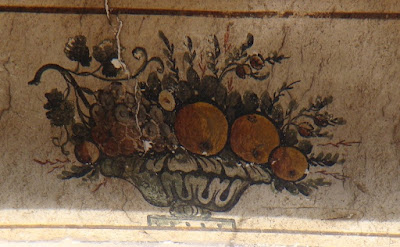From a house on Plapoutsas, the only surviving eave paintings from newly-independent Nauplion. I discussed one of the paintings here some time ago. A few other houses continue the tradition of stencils, quite garish in contrast to these that evoke Roman fresco. They all derive from Turkish styles of house decoration. I hope the archaeological authorities of Nauplion will make some effort to stabilize and conserve these lovely paintings.
Later: That was obviously wishful thinking. I am adding photographs made in November 2010 sent by Brigitte Eckert who has been responsible for the Bettina Schinas translation. Mine were taken in early 2009. Notice the amount of deterioration in less than two years, particularly at the corner.
Later: That was obviously wishful thinking. I am adding photographs made in November 2010 sent by Brigitte Eckert who has been responsible for the Bettina Schinas translation. Mine were taken in early 2009. Notice the amount of deterioration in less than two years, particularly at the corner.









I have absolutely no idea of Turkish style hourse decoration. That's why I thought this beautiful decoration in the category of Bavarian Lueftl painting:
ReplyDeletehttp://commons.wikimedia.org/wiki/Category:L%C3%BCftlmalerei?uselang=de
It is next to the Armansperg's residence and there must have lived Bavarians in this house in the early 1830s, before Athens became the Greek capital 1834.
I'll mail you some sad evidence about the worse condition of the paintings in Nov. 2010.
I wish there were possibilities to raise donations to save them, Greece won't be able to spend money on them for many years...
I wrote about one of these pictures before, & tend to think they were painted after the Bavarians left. http://surprisedbytime.blogspot.com/2009/07/nauplion-walls.html
ReplyDeleteThe style and coloration are much more in the Turkish tradition, to my mind, than the western European, although the content -- with the exception of the bird and the fruit -- shifts.